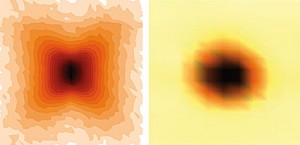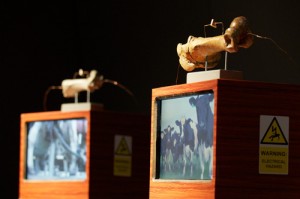When I was working on my undergraduate communications degree, we spent a fair chunk of time discussing the printed word; this introduction (below in the excerpt) brings back memories. I am going to start with an excerpt from the study (link and citation to follow at the end of this post) before moving on to the news item and press release. It’s a good introduction (Note Links have been removed),
For a long time, paper has been used as storing medium for written information only [emphasis mine]. In combination with the development of printing technologies, it became one of the most relevant materials as information could be reproduced multiple times and brought to millions of people in a simple, cheap, and fast way. However, with the digital revolution the end of paper has been forecasted.
However, paper still has its big advantages. The yearly production is still huge with over 400 million tons worldwide[1] for a wide application range going much beyond conventional books, newspapers, packages, or sanitary products. It is a natural light‐weight, flexible, recyclable, multi‐functional material making it an ideal candidate as part of novel electronic devices, especially based on printed electronics.[2] During the last decade, a wide variety of electronic functionalities have been demonstrated with paper as the common substrate platform. It has been used as basis for organic circuits,[3] microwave and digital electronics,[4] sensors,[5-7] actuators,[8, 9] and many more.
…
My first posting about this work from Chemnitz University of Technology with paper, loudspeakers, and printed electronics was a May 4, 2012 posting.
Enough of that trip down memory lane, a January 26, 2021 news item on Nanowerk announces research into printing loudspeakers onto roll-to-roll printed paper,
If the Institute for Print and Media Technology at Chemnitz University of Technology [Germany] has its way, many loudspeakers of the future will not only be as thin as paper, but will also sound impressive. This is a reality in the laboratories of the Chemnitz researchers, who back in 2015 developed the multiple award-winning T-Book – a large-format illustrated book equipped with printed electronics. If you turn a page, it begins to sound through a speaker invisibly located inside the sheet of paper.
“The T-Book was and is a milestone in the development of printed electronics, but development is continuing all the time,” says Prof. Dr. Arved C. Hübler, under whose leadership this technology trend, which is becoming increasingly important worldwide, has been driven forward for more than 20 years.
…
A January 26, 2021 Chemnitz University of Technology press release by Mario Steinebach/Translator: Chelsea Burris, which originated the news item, delves further into the topic,
From single-sheet production to roll-to-roll printing
Five years ago, the sonorous paper loudspeakers from Chemnitz were still manufactured in a semi-automatic single-sheet production process. In this process, ordinary paper or foils are printed with two layers of a conductive organic polymer as electrodes. A piezoelectric layer is sandwiched between them as the active element, which causes the paper or film to vibrate. Loud and clear sound is produced by air displacement. The two sides of the speaker paper can be printed in color. Since this was only possible in individual sheets in limited formats, the efficiency of this relatively slow manufacturing process is very low. That’s why researchers at the Institute of Print and Media Technology have been looking for a new way towards cost-effective mass production since May 2017.
The aim of their latest project, roll-to-roll printed speaker paper (T-Paper for short), was therefore to convert sheet production into roll production. “Researchers from the fields of print media technology, chemistry, physics, acoustics, electrical engineering, and economics from six nations developed a continuous, highly productive, and reliable roll production of loudspeaker webs,” reports project manager Georg C. Schmidt. Not only did they use the roll-to-roll (R2R) printing process for this, but they also developed inline technologies for other process steps, such as the lamination of functional layers. “This allows electronics to be embedded in the paper – invisibly and protected,” says Hübler. In addition, he says, inline polarization of piezoelectric polymer layers has been achieved for the first time and complete inline process monitoring of the printed functional layers is possible. The final project results were published in the renowned journal Advanced Materials in January 2021.
Long and lightweight paper loudspeaker webs for museums, the advertising industry, and Industry 4.0
The potential of loudspeaker paper was extended to other areas of application in the T-Paper project. For example, meter-long loudspeaker installations can now be manufactured in web form or as a circle (T-RING). “In our T-RING prototype, an almost four-meter-long track with 56 individual loudspeakers was connected to form seven segments and shaped into a circle, making a 360° surround sound installation possible,” says Schmidt. The speaker track, including printed circuitry, weighs just 150 grams and consists of 90 percent conventional paper that can be printed in color on both sides. “This means that low-cost infotainment solutions are now possible in museums, at trade shows and in the advertising industry, for example. In public buildings, for example, very homogeneous sound reinforcement of long stretches such as corridors is possible. But the process technology itself could also become interesting for other areas, such as the production of inline measurement systems for Industry 4.0,” says the project manager, looking to the future.
The T-Paper project was funded by the Federal Ministry of Education and Research from 2017 to 2020 with 1.37 million euros as part of the Validation of the technological and societal innovation potential of scientific research – VIP+ funding measure.
Here’s a link to and a citation for the paper,
Paper‐Embedded Roll‐to‐Roll Mass Printed Piezoelectric Transducers by Georg C. Schmidt, Pramul M. Panicker, Xunlin Qiu, Aravindan J. Benjamin, Ricardo A. Quintana Soler, Issac Wils, Arved C. Hübler. Advanced Materials DOI: https://doi.org/10.1002/adma.202006437 First published: 18 January 2021
This paper is open access.
For anyone curious about the T-Paper project, you can find it here.


